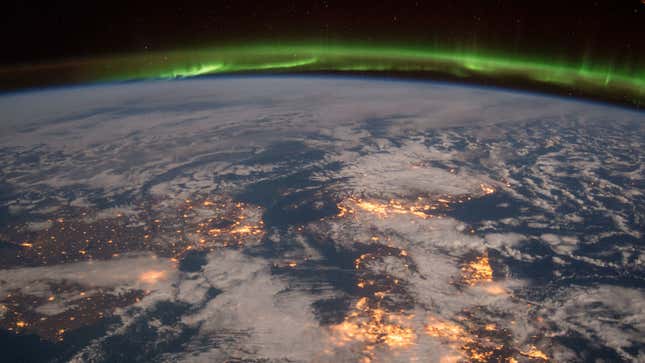
In an era of the climate crisis, it’s easy to imagine things getting worse because that’s all we know.
Greenhouse gas emissions have risen steeply since the Industrial Revolution; 40 percent of all carbon pollution in the atmosphere has been chucked up there in the past two decades alone. Chaos has followed, from rising seas to destructive weather, while callous politicians and oligarchs have done everything in their power to let the world burn faster. It’s not hard to imagine all the ways things can continue to go to hell.
Meteorologist and writer Eric Holthaus’ new book, The Future Earth, asks readers to imagine something different: a world where we thread the needle to protect the climate and each other. In doing so, it reveals that the guts of the climate crisis aren’t solely the unwavering physics of carbon warming the planet; it’s our ability to picture something better. The Future Earth breaks the spell of capitalism that has spent decades distracting us from the fact that a better world is possible and shows what 30 years of radical transformation could look like. (I should note here we did the same Master’s program a year apart, and I consider Eric a friend.)
Whereas David Wallace Wells’ The Uninhabitable Earth asked readers to consider the horrors of unchecked climate change, Holthaus’ The Future Earth asks that we consider what happens when we collectively come together to scramble back from the brink. It’s one of a handful of recent books to make the case for radical change, including A Planet to Win and The Future We Choose.
One element that sets The Future Earth apart is a turn toward speculative fiction showing a pathway the world could follow over the next three decades. Holthaus has a background in meteorology and climate science, and that’s reflected in the book, which functions as a sort of modeling exercise for humanity. While climate scientists set models in motion to look at the atmosphere, Holthaus sets in motion a model for cutting carbon emissions to net-zero and reconciling the West’s intertwined legacy of colonialism and capitalism over the next 30 years.
Among the steps are everything from “a revolutionary change in mindset ... in favor of systems that are designed to put our personal and planetary health first” to how the Green New Deal could spread around the globe, to creating new metrics of success beyond GDP, to a four-day workweek and enjoying a life of leisure. The core message of the book is that we need to completely change our relationship with the planet and each other, not just build a bunch of solar farms and machines to suck carbon out of the sky (though we certainly do need both).

“This book is an example of what it might look like when we win,” Holthaus writes.
The world sorely needs this type of thinking. For too long, powerful corporations and politicians have asked us to dull our imaginations and splinter ourselves into groups pitted against each other. The dumb-down, divide-and-conquer approach has paid dividends to a small group of wealthy people.
The world is now at an inflection point—people are rightfully pissed about injustices wrought by that system, from the climate crisis to police brutality. And they’re ready to create something new. Yet, as Naomi Klein notes in the foreword of A Planet to Win, “generations who had grown up under neoliberalism’s vice grip struggled to picture something, anything, other than what they had always known.”
That’s starting to change, though, whether its calls to defund the police or the Green New Deal. Rep. Alexandria Ocasio-Cortez narrated a video for the Intercept last year showing what unfettered imagination for the latter could look like. Holthaus’ book will spark further discussion on how we go forward.
None of this is to say everything will go right or that it’s not a steep slope. We live in a moment of possibility and peril. As a growing number of people rally for a better world, it will only lead to a more intense, reactionary backlash. See the violent police response to police brutality protests or oil companies and Republicans lashing out in response to climate protests and market shifts making oil less profitable. The reality is also that a number of people, particularly in the developed world, are fairly comfortable. Even if they support more aggressive climate action, they may still balk at having to leap into the unknown. The Future Earth is, in some ways, a parachute. As we fall at terminal velocity into a new future, it opens up to reveal the landscape below, including the safest spots to land.
Holthaus notes the challenges ahead and grapples with thorny questions around geoengineering the globe to bring down the heat and the fact that people will still die and be displaced by climate chaos regardless of what we do or manage to imagine, but we can’t afford to ignore these questions simply because they are hard. The book ends with a visioning exercise for readers to chart their own fixes at a level they can control, whether it be their household or neighborhood (or if you happen to be a head of state, a country).
Now, more than ever, we need to think differently. But just as important as imagining a better world is putting the actual work in to build it. That may feel hard, but as Holthaus notes, “the old world is dead—what comes next is up to us.”